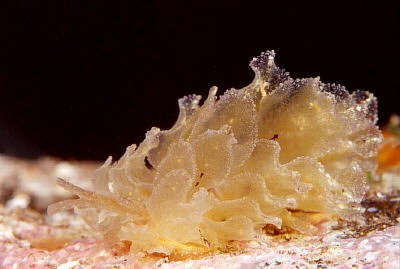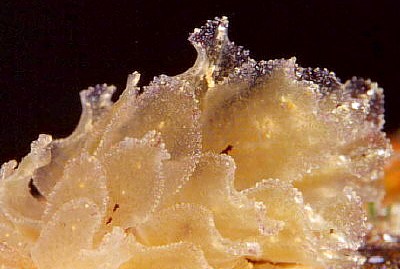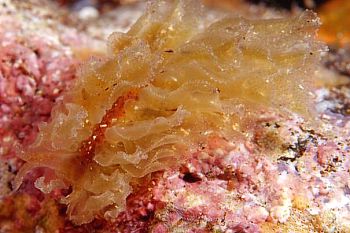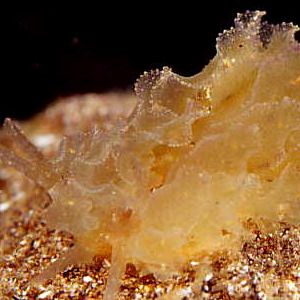

Polybranchia viridis
(Deshayes, 1857)
Order: SACOGLOSSA
Superfamily: LIMAPONTIOIDEA
Family: Caliphyllidae
DISTRIBUTION
Caribbean, Pacific coast of Mexico, Canary Ids
PHOTO
Canary Islands, depth 3m, size 15 mm, Gran Canaria Is., divesite "Sardina del Norte", Jan. 18, 2001. Photo: Arthur J. Telle
Polybranchia viridis is characterised by small papillae all over the face of the cerata and the rhinophores.
References:
• Ortea, J.A. (1981) Moluscos Opistobranquios de las Islas Canarias. Primera parte: Ascoglosos. Bol. Inst. Espa. Oceano, 6: 179-199
• Ortea, J.A. & Templado, J. (1990) A new species of the genus Cyerce Bergh, 1871, from the Cape Verde Islands (Opisthobranchia: Ascoglossa). The Veliger, 33(2): 202-205.
• Thompson, T.E. (1988) Eastern Mediterranean Opisthobranchia: Oxynoidae, Polybranchiidae, Stiligeridae (Sacoglossa). Journal of Molluscan Studies, 54: 157-172.
Rudman, W.B., 2001 (March 21) Polybranchia viridis (Deshayes, 1857) . [In] Sea Slug Forum. Australian Museum, Sydney. Available from http://www.seaslugforum.net/find/polyviri
Related messages
Re: Polybranchia from the Canary Ids
March 29, 2001
From: Erwin Koehler


Bill,
Here are 2 more photos of Polybranchia from the Canary Ids.
Erwin
Erwin@medslugs.de
Koehler, E., 2001 (Mar 29) Re: Polybranchia from the Canary Ids. [Message in] Sea Slug Forum. Australian Museum, Sydney. Available from http://www.seaslugforum.net/find/4051Thanks Erwin,
The tubercles on the cerata are quite clear in the lower photo, so I think that confirms that it is Polybranchia viridis.
Best wishes,
Bill Rudman.
Re: Polybranchia from the Canary Ids
March 23, 2001
From: Kathe R. Jensen
Dear Bill & Erwin,
The easiest way to distinguish Cyerce and Polybranchia is the presence of digestive gland tubules in the cerata of Polybranchia (absent in Cyerce). However, the specimen in the photo is so pale that it is not possible to see whether the yellowish colour of the central part of the cerata is due to faded digestive gland or not. Also, in Polybranchia the base of the cerata looks like it is "rolled in", forming like a stem of a flower petal.
Besides Polybranchia viridis, P. borgnini (Trinchese, 1896) has also been recorded from the Canary Islands (Ortea, 1981). According to this paper and to Thompson (1988) P. viridis has tuberculate cerata, whereas those of P. borgnini are smooth (I have only seen 1 specimen of P. viridis in Florida, and that was a long time ago). The reddish-brown pigment spots on the cerata occur in P. borgnini, but also in Cyerce cristallina (see Thompson, 1988).
Cheers,
Kathe
References:
• Ortea, J. (1981) Moluscos opistobranquios de las Islas Canarias. Primera parte: Ascoglosos. Boletim do Instituto Espana Oceanografico 6: 180-199.
• Thompson, T.E. (1988) Eastern Mediterranean Opisthobranchia: Oxynoidae, Polybranchiidae, Stiligeridae (Sacoglossa). Journal of Molluscan Studies, 54: 157-172.
jensen@ait.ac.th
Jensen, K.R., 2001 (Mar 23) Re: Polybranchia from the Canary Ids. [Message in] Sea Slug Forum. Australian Museum, Sydney. Available from http://www.seaslugforum.net/find/4020
Dear Kathe,
Unfortunately all the 'easy' ways of distinguishing the two genera don't work when the characters are not clear in the photo. I am hoping that someone with local knowledge will be able to recognise the species from the photo. I think I can see brownish-yellow branches of the digestive gland in the cerata, and small tubercles over the face of the cerata, like those around the ceratal edge, which would make it Polybranchia viridis.
Cheers,
Bill Rudman
Polybranchia from the Canary Ids
March 20, 2001
From: Erwin Koehler

Dear Bill
Here is one from the Canary Islands, depth 3m, size 15 mm, Gran Canaria Is., divesite "Sardina del Norte", Jan. 18, 2001.
It was taken by Arthur J. Telle: [mercedes@idecnet.com
www.spain-service.com/arturo]
Erwin
Medslugs.Koehler@t-online.de
Koehler, E., 2001 (Mar 20) Polybranchia from the Canary Ids. [Message in] Sea Slug Forum. Australian Museum, Sydney. Available from http://www.seaslugforum.net/find/3976Dear Erwin,
It looks like the animal Ortea & Templado (1990) describe as Cyerce verdensis but most probably is Polybranchia viridis (Deshayes, 1857) which has been reported from the Canary Ids (Ortea 1981). Ortea's photo looks much like Arthur Telle's. [Until Ortea's record, P. viridis was only known from the Caribbean and the Pacific coast of Mexico]
One big problem is I that I can't see the foot. In Cyerce there is a transverse groove across the sole of the foot behind the head, while in Polybranchia there is not, so it is not possible for me, solely from the photo, to place the species in a genus.
References:
• Ortea, J.A. (1981) Moluscos Opistobranquios de las Islas Canarias. Primera parte: Ascoglosos. Bol. Inst. Espa. Oceano, 6: 179-199
• Ortea, J.A. & Templado, J. (1990) A new species of the genus Cyerce Bergh, 1871, from the Cape Verde Islands (Opisthobranchia: Ascoglossa). The Veliger, 33(2): 202-205.
